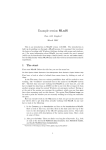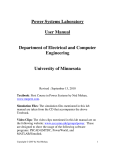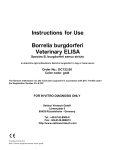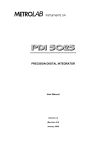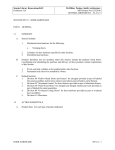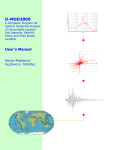Download User Manual for RSPMatch09
Transcript
User Manual for RSPMatch09 Introduction RSPMatch09 performs time-domain spectral matching by adding adjustment wavelets to an initial acceleration time series to generate a modified time series whose response spectrum is compatible with a specified target response spectrum. The original program was developed by N. A. Abrahamson (1993) to implement the Lilhanand and Tseng (1987, 1988) algorithm and modified in 1999 to preserve the non-stationary character of the initial ground motion at long periods. The new version of the program includes a new wavelet adjustment function that provides a stable and time-efficient solution without causing drift in the resulting velocity and displacement time series. The main new features in RSPMatch09 consist of: • An improved tapered cosine adjustment function (model 7) that prevents drift in the modified velocity and displacement time series. Stability and time-efficiency of the solution are ensured by using analytical functions to calculate the elements of matrix C. • Dynamic padding of the beginning of the acceleration time series performed when the time of its peak response at a certain frequency (tj) is small compared to the duration of the record. • Using the new model to perform spectral matching to a target pseudo-acceleration response spectrum instead of a target acceleration response spectrum. • Using Newmark’s integration scheme for the calculation of the pseudo-acceleration response spectra to guarantee unconditional stability of the results. The accuracy of the numerical solution at high frequencies is ensured by allowing local dynamic interpolation of the acceleration record such that the maximum ratio between the integration time step and the period of the oscillator is always less that a certain tolerance (0.01). • Performing the different spectral matching passes in a single step since no baseline correction of the resulting acceleration time series from each pass is needed. The old adjustment functions that were available in RSPMatch99 are also included in RSPMatch09, but we recommend the use of the new and improved adjustment function (model 7). To run RSPMatch09, the user needs the program executable, reference acceleration file, target response spectrum file, input file and parameter files for the different passes. RSPMatch09 will produce three output files for each pass consisting of a modified acceleration time series, spectral response at the frequencies requested to be matched and spectral response at the unmatched frequencies. Input Files The input files to RSPMatch09 have the extension *.inp. Since the short period spectral accelerations are influenced by long period wavelets, time series adjustment is usually done in multiple passes, starting at short periods and progressively adjusting longer periods. When running RSPMatch09, the user is prompted to enter the name of the input file, which contains the number of passes and the names of the corresponding run files. The input file has the following format: nPass Number of adjustment passes. *.inp Name of the first run file. The user can run all the spectral matching passes at once by setting nPass equal to the total number of passes and specifying the corresponding run file names on the subsequent lines. Similarly, the user can choose to run only one pass by setting nPass to 1 and specifying the name of a particular run file. Run files have the same format as the one used in RSPMatch99 and consists of: MaxIter Maximum number of iterations for spectral matching. This value is typically set between 5 and 20 depending on how close the initial response spectrum is to the target spectrum. Tol Tolerance for maximum mismatch in fraction of target. This value is typically set to 0.05 for 5% maximum deviation from the target spectrum. Gamma Convergence damping. This factor specifies the fraction of adjustment made to the acceleration time series at each iteration. This parameter is usually set to 1. iModel Flag indicating the adjustment model to be used in spectral matching. While RSPMacth09 contains the adjustment models that were available in RSPMatch99, we recommend the use of the new and improved adjustment model (iModel = 7). The available wavelet functions are: 1 Reverse acceleration impulse response function based on Lilhanand and Tseng (1987, 1988). 6 Tapered cosine function. 7 Improved tapered cosine function. Adjustment model 1 does not preserve the non-stationary character of the initial time series and we therefore recommend against using it. Adjustment model 6 preserves the non-stationary character of the reference time series but causes drift in the resulting velocity and displacement time series. When using this model, the user needs to apply a baseline correction to the modified acceleration time series after each pass to correct for this drift. Adjustment model 7 prevents drift while preserving the non-stationary character of the ground motion. Moreover, it ensures fast and stable solution by using analytical integrations for the calculation of the elements of matrix C. We recommend using model 7 for best results. Note that models 1 and 6 are programmed to perform spectral matching to a target acceleration response spectrum. On the other hand, model 7 is designed to perform pseudo-acceleration spectral matching. a1, a2, f1, f2 Parameters that describe the frequency dependence of the taper for adjustment model 6. The frequency dependence of the taper should be consistent with the reference time series. That is, if the reference time series has a short duration at a particular frequency, the taper parameters should be selected such that the adjustment function at that frequency also has a short duration. The taper function for adjustment model 6 is defined by: If model 7 is selected, the user can enter any default values for these taper parameters as they will not affect the results. Scale, Per Flag to linearly scale the acceleration time series and the response spectrum to match the target spectrum at the specified period, Per. The scaling flag can take the following values: 0 No scaling is applied 1 Scaling the acceleration time series before and after each iteration 2 Scaling the initial time series to match the target spectrum at the specified period only before the first iteration Scaling the acceleration time series to an initial spectral or pseudo-spectral acceleration is useful and can reduce the number of iterations necessary for matching. Therefore, we recommend scaling the reference acceleration time series only before the first iteration (scale flag set to 2) to the peak ground acceleration in the first pass. Scaling is recommended to be turned off in subsequent passes. dt flag Interpolation factor (integer greater than or equal to 1) used to interpolate the acceleration time series to 1/dtflag of the input time step. evmin Minimum normalized eigenvalue used in the singular value decomposition (SVD). The recommended value for this parameter is 1.0e-4. Groupsize Number of spectral values to use in matching one subgroup. This parameter is typically set to 30. MaxFreq Maximum frequency (Hz) up to which spectral matching is performed. f1, f2, npole Parameters used to set the frequency band and the number of poles for the bandpass filter to be applied to the initial acceleration time series. The use of this filter is not recommended as it might introduce drift to the velocity and displacement time series. iModPGA Peak ground modification flag. This parameter should be set to 1 for modifying PGA or 0 otherwise. If Model 7 is selected, this parameter is not used in the code and a default value can be entered. iSeed, RanFactor Parameters used to randomize the target response spectrum by introducing random variations about the mean target spectrum. iSeed is the seed number for the random number generator, while RanFactor sets the amplitude of variation. The use of target randomization is not recommended and these parameters are typically set to zero. freqMatch1, freqMatch2 Frequency range for spectral matching. Spectral matching for a certain pass is performed for all frequencies between freqMatch1 and freqMatch2. Since short period spectral accelerations are influenced by long period wavelets, it is recommended to do spectral matching in multiple passes. The first pass is typically performed for a frequency range of 1 to 100Hz. Longer periods are matched progressively in subsequent passes. Baseline Cor Flag Baseline correction flag. When set to 1, this flag applies baseline correction to the acceleration time series following each iteration. When this flag is set to zero, no baseline correction is applied. For Model 7, baseline correction is not active regardless of the value of this flag. Scale Factor Scale factor used to scale the initial acceleration time series prior to spectral matching. *.tgt Filename of the target response spectrum. *.acc Filename of the reference acceleration time series. *.acc Output filename of the modified acceleration time series resulting from this pass. *.rsp Name of the output file containing the modified spectral accelerations (for models 1 and 6) or pseudo-spectral accelerations (for model 7) at the frequencies requested to be matched. *.unm Name of the output file containing the modified spectral or pseudo-spectral accelerations at the unmatched frequencies. Reference Acceleration Time Series The reference acceleration time series should have the following format: Title Title having a maximum of 80 characters in length nPts, dt, nAdded Total number of acceleration points, time step and number of zero acceleration points added at the beginning of the time series for padding. nAdded is usually zero for the initial acceleration time series used in the first pass of spectral matching. If adjustment model 7 is used, the acceleration time series generated from a certain pass and used as an input for the next pass might have nonzero nAdded if padding occurred. Acc Multi-column list of acceleration values in g. Target Response Spectrum The target response spectrum should have the following format: Title Title having a maximum of 80 characters in length nPer, nDamp Number of data points in the target response spectrum and the number of damping values. Damp1, Damp2… Damping values corresponding to nDamp Freq, T1, T2, SA1, SA2… Column arrays of frequency, time 1, time 2 and spectral or pseudospectral acceleration values in g to be matched to at each specified damping level. T1 and T2 specify the time window for the application of the adjustment wavelet to the acceleration time series. It is recommended to set T1 to zero and T2 to a sufficiently large number that will exceed the duration of the acceleration time series. Output Files RSPMatch09 generates three output files for each matching pass. The names of these output files are specified in the corresponding input run files. The output files consist of an acceleration time series file, response spectra files at the requested and unmatched frequencies. The acceleration time series file has the extension *.acc and has the same format as the reference acceleration file. If Model 7 is used, the initial acceleration time series is dynamically padded to prevent drift in the velocity and displacement time series. In such case, the modified acceleration time series will be longer than the initial time series. The additional number of acceleration points is given by nAdded. The user can remove these additional acceleration points and taper the beginning of the acceleration time series. Although drift will not occur in the modified time series, accelerations, velocities and displacements might still end with a nonzero value in cases where the response of the acceleration time series peaks at high tj values relative to the duration of the record. In such cases, the user can apply a taper to bring the end of the time series to zero. Output files with extension *.rsp provide details of the spectral or pseudo-spectral accelerations of the adjusted time series at the frequencies requested to be matched. If adjustment models 1 or 6 are selected, spectral accelerations are generated by the program. If model 7 is used, RSPMatch09 generates pseudo-spectral accelerations. Output files with extension *.unm provide details of the spectral or pseudo-spectral accelerations of the modified time series at the unmatched frequencies. Example Example input and corresponding output files are provided with the program. After running the executable file, the program will prompt the user to enter the input file name with the full path if the file is located in a different folder and the extension (.inp). Spectral matching will then be performed for the different passes specified in the input file. Three output files will be generated for each pass. References Abrahamson, N. A., 1992. Non-stationary spectral matching, Seismological Research Letters, 63(1), 30. Hancock, J., Watson-Lamprey, J., Abrahamson, N. A., Bommer, J. J., Markatis, A., McCoy, E. and Mendis, R., 2006. An improved method of matching response spectra of recorded earthquake ground motion using wavelets, J. of Earthquake Eng., 10 (Special Issue 1), 67-89. Lilhanand, K. and Tseng W. S., 1987. Generation of synthetic time histories compatible with multiple-damping response spectra, SMiRT-9, Lausanne, K2/10. Lilhanand, K. and Tseng W. S., 1988. Development and application of realistic earthquake time histories compatible with multiple damping response spectra, Ninth World Conf. Earth. Engin., Tokyo, Japan, Vol 2, 819-824.






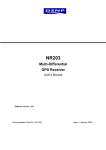


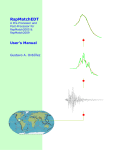
![[U2.05.09] Notice d`utilisation de la méthode GTP](http://vs1.manualzilla.com/store/data/006374519_1-f40be16fe141ef3337c3d5ec16dd7c80-150x150.png)

![[U2.05.09] Notice d`utilisation de la méthode GTP](http://vs1.manualzilla.com/store/data/006365089_1-b6da642e2f9466f28bba89035179d5dc-150x150.png)
